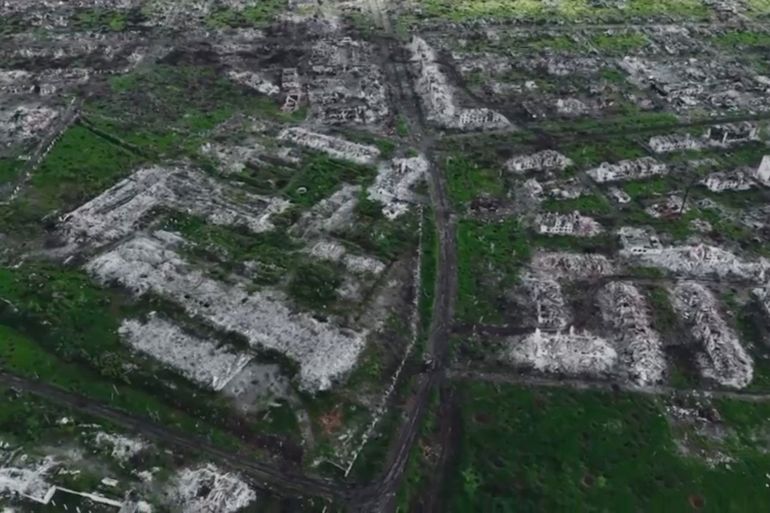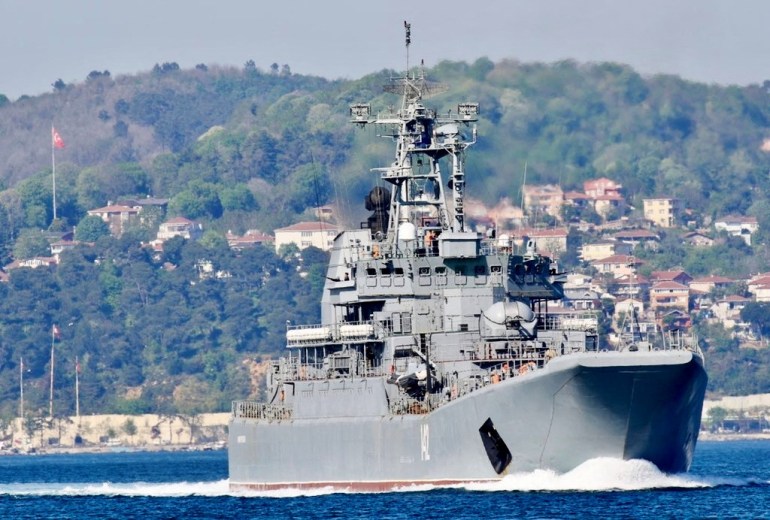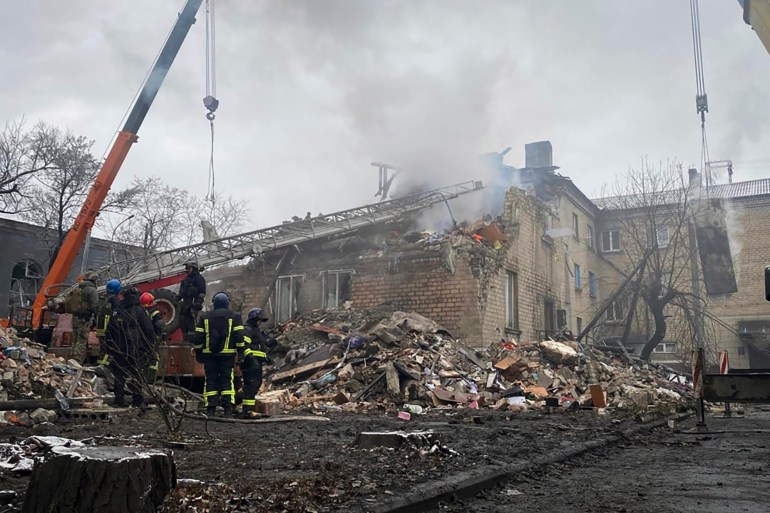Ukraine drives Russia back at sea and in the air, but concedes land
Russia lost a landing ship and five planes this week, but took a flattened suburb.

Ukraine claimed an ammunition-laden Russian ship and five Sukhoi fighters and bombers this week but made a tactical retreat in the east to preserve its fighting force.
Ukrainian fighter planes launched cruise missiles against the Novocherkassk, a Ropucha-class landing ship at a port in Feodosia, on the eastern side of the Crimean peninsula, on the night of December 25-26.
Keep reading
list of 4 itemsRussia pushes into Ukraine’s Kharkiv as Putin announces China trip
US promises Ukraine military aid to make ‘real difference’ on the way
Russia-Ukraine war: List of key events, day 810
Ukrainian Air Force chief Mykola Oleshchuk posted video of a massive explosion that came after the initial impact of the missiles had set the ship alight, suggesting the Novocherkassk was laden with weapons or munitions that detonated.
Russia’s defence ministry admitted only that the ship had been damaged, but daytime satellite pictures showed the burned ship half-submerged at its berth on December 27.
“We can see how powerful the explosion was, what the detonation was like. After that, it’s very hard for a ship to survive, because this was not a rocket, this is the detonation of munitions,” Ukrainian Air Force spokesman Yuri Ignat told Radio Free Europe.
Sergei Aksyonov, the Russian-installed governor of Crimea, said on Telegram that one person had been killed and the Russian RIA news agency said four people had been injured, but the death toll may have been as high as 80, the Ukrainian navy said, citing reports that 77 personnel were on board the ship at the time of the blast.
The attack was an example of the success Ukraine has had this year in striking Russian assets at range, partly thanks to Storm Shadow and SCALP missiles it has received from Britain and France, and partly thanks to the aerial and surface drones it has been developing.
On the day the Novocherkassk was hit, Ukraine’s Security Service (SBU) unveiled the Mamai, a new surface drone with a top speed of 110km/h, claiming it was “the fastest object on the Black Sea to date”. Ukraine has already used Sea Baby drones successfully to damage Russian ships at Sevastopol and Novorossiysk ports, and to strike the Kerch Bridge.

Successes in the air war
Ukraine also remained alert to opportunities to down Russian aircraft that stray too near the front.
On December 23, Ukraine’s Air Force said it downed three Russian Sukhoi-34 bombers, two over Odesa and one in the direction of the Russian region of Bryansk. Air Force spokesman Ignat said the Russian pilots were caught unaware when they tried to fly close to Ukrainian combat lines to release glide bombs. “UAVs weighing 500kgs can fly 20–25 kilometres from the line of combat. When you need to strike further, you need to fly closer,” said Ignat. “But our defenders caught the invaders by surprise.”
The following day Ukraine’s Air Force said it had downed a Russian Sukhoi-30 fighter and another Sukhoi-34 bomber, without specifying where or how.
“What the Ukrainians used has not yet been confirmed, but the evidence points extremely strongly towards the use of Patriot anti-air missiles,” wrote strategy professor at St Andrews University Phillips O’Brien, citing an incident on May 12, when Ukraine shot down four Russian aircraft in Russian airspace.
“What later emerged is that the Ukrainians had laid a trap for the Russians. They had secretly moved one of their new Patriot batteries [that had just become functional in Ukraine] very close to the Russian border in Kharkiv oblast. From there, the Ukrainians could reach into Russia itself and ambush the unsuspecting Russians.”
If that assessment is accurate, it would explain why Moscow was so upset when Japan modified its laws to be able to export a Patriot system back to the United States. While it still refuses to export arms to an active war theatre, Japan’s move gives the US extra capacity in Patriot systems, allowing the US to ship the system to Ukraine.
“It cannot be ruled out that under an already tested scheme Patriot missiles will end up in Ukraine,” Russian foreign ministry spokesperson Maria Zakharova told a weekly briefing on December 27. Such a scenario would be “interpreted as unambiguously hostile actions against Russia and will lead to grave consequences for Japan”.
Ukraine has also been doing extremely well in safeguarding its airspace from a nightly onslaught of Iranian-designed Shahed drones launched by Russia.
During the week of December 21-27, it downed 154 drones of 177 launched by Russia, an 87 percent kill rate. The previous week it scored a 98 percent kill rate. Ignat recently said Ukraine has downed 2,900 out of 3,700 drones launched by Russia during the war. Both of the last two weekly scores were higher than the average kill rate of 78 percent, suggesting that Ukraine’s air defences are adapting.
Ukraine is about to receive a boost to its air defences.
“Today I informed President [Volodymyr] Zelenskyy of our government’s decision to prepare an initial 18 F-16 fighter aircraft for delivery to Ukraine,” Dutch caretaker prime minister Mark Rutte said in a post on social media platform X on December 22.
It was not clear when the planes would be delivered, but a recent Estonian defence ministry strategy document said the Netherlands, Denmark, Norway and Belgium have already committed to donating F-16s to Ukraine “before the end of the year”.
Ukrainian pilots have been training on F-16s in Britain, the US and Romania for much of this year.

‘Throwing personnel to their death’
The ground war is where Ukraine faced difficulties.
Russia claimed control of Maryinka, a suburb of the occupied Donetsk city in the east, on December 24. “Our assault units … have today completely liberated the settlement of Maryinka,” Defence Minister Sergei Shoigu told Russian President Vladimir Putin in a televised meeting.
“What is important is that we have quite significantly moved the work of artillery further from Donetsk to the west,” Shoigu said, offering Donetsk city a broader defensive envelope.
Ukraine insisted it was still within the town’s administrative limits: Commander-in-Chief Valery Zaluzhny said a tactical decision had been made to give up most of Maryinka to save lives – except for a garrison left holding the north of the neighbourhood. “The method is absolutely the same as it was in Bakhmut – our fighters are destroyed street by street, block by block – and after that we have what we have,” Zaluzhny said.
Unlike in Bakhmut, Ukraine made a decision not to fight for every last square foot. Yet, as was the case in other cities Russia has taken – Mariupol, Bakhmut, Severdonetsk and Lysychansk – the fighting needed to capture Maryinka was so severe that nothing of the city remained. An aerial photograph circulated by Anton Gerashchenko, a Ukrainian interior ministry adviser, showed the suburban Donetsk town, which had a pre-war population of 10,000, so destroyed that not a single building appeared habitable. One or two exterior walls were all that remained of most houses. In many cases, buildings had been bombed to their foundations.
Russian leaders made much of this achievement. Defence Minister Sergei Shoigu spoke of the difficulty of storming well-protected machine-gun positions connected by underground passages, and even aggrandised the event by pointing out that Maryinka was taken by the 150th motorised rifle Idritsa-Berlin Order of Kutuzov division, which seized the Reichstag building in 1945.
Still, Maryinka is less than a kilometre from the pre-invasion front line of February 2022 and there are signs of Russian frustration at the glacial pace of its gains, despite Russia’s vastly greater resources.
On the Left Bank of the Dnipro river in Kherson, where Ukrainian forces have established a small bridgehead during the autumn, neither Russian marines nor the newly formed 104th Air Assault Division have been able to dislodge them. In the 96th week of the war, Russia appears to have broken international law and used tear gas.
Russia’s 810th Naval Infantry Brigade posted on December 23 that it had adopted a “radical change in tactics” near Krynky in Kherson, “dropping K-51 grenades from drones” onto Ukrainian positions.
“K-51 aerosol grenades are filled with irritant CS gas, a type of tear gas used for riot control (also known as a Riot Control Agent [RCA]),” wrote the Washington-based Institute for the Study of War. “The Chemical Weapons Convention prohibits the use of RCAs as a method of warfare, and Russia has been a state party to the CWC since 1997,” it said.
Ukraine is also suffering from fatigue in this war. Its parliament on December 25 posted a draft law lowering the conscription age from 27 to 25. Zelenskyy had said in a recent press conference that the military wishes to raise 450,000-500,000 personnel next year to replenish losses, increase combat capacity and introduce rotation of front-line personnel.
Russia wants to capture Avdiivka on the eastern front this year “at a minimum”, said Ukrainian Brigadier-General Oleksandr Tarnavskyi, who commands the Tavria group of forces, encompassing Avdiivka, Mariivka and Robotyne, in an interview with BBC Ukraine.
“The enemy uses its strengths – manpower, minefields, prepared positions, as well as the readiness to mercilessly throw its personnel to [their] death,” he said.
“I think that the next year will be, perhaps, even more difficult.”